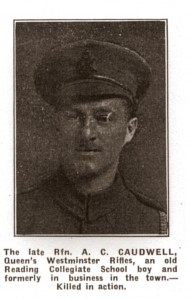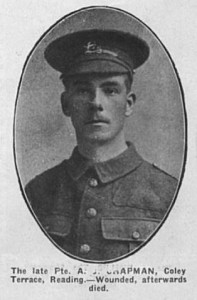Arthur Cyril Caudwell
Rifleman 6175
1st/16th Bn. London Regt. (Queens Westminster Rifles)
Division 55
 |
Arthur C. Caudwell is commemorated on a large family headstone. It is not clear exactly who his parents were and CWGC information has been difficult to trace. A search for “Caudwell” has consistently drawn a blank but a search for A. C. C. revealed that an Arthur Candwell was killed on 9th October 1916, there are no family details given and the soldier has no known grave and is commemorated on the Thiepval memorial to the Missing Pier and Face 13C.
HIs military papers are available on Ancestry UK. He attested in November 1915 and was posted to France in April 1916. His brother Thomas, of 35. Bulmershe Road, Reading was given as his next of kin.
The inscription on the family headstone states:
”Killed by a shell whilst guarding a trench October 10th 1916 Aged 36.
His body was buried by his comrades on the battlefield near Lesboeufs.”
At the time of Caudwell’s death the concluding battles of the Somme were taking place and the British lines had moved to a point a little way beyond Lesboeufs by October 10th 1916. Lesboeufs had been captured on the 25th September by the British. Earlier action on 15th September 1916 has seen the first tanks in action in the area west of Lesboeufs. The Somme battle had concluded by 18th November 1916.
Although the body of Arthur Caudwell was buried on the battlefield and the grave was marked the continuous shelling in the period leading up to the end of the battle could have destroyed the grave. In these circumstances identification after the war would have been impossible.
More information was obtained from the Standard 28th October 1916 in the detailed “War Casualties” obituary column. The article gave full details of how he died and confirmed that he was buried on the battlefield, the grave subsequently being lost.
KILLED IN ACTION
CAUDWELL, Rfn. A.C., Queen’s Westminster Rifles.
“Mr Caudwell, who was an architect with Mr. Willets, builder, London, was an old Collegiate School boy. His father for many years was with Messrs. Sutton and Sons, and his brother lives at 35, Bulmershe Road, Reading.
The Platoon Officer writes:- He was always bright and cheery, and is deeply missed by all his friends. I myself, too, greatly regret the loss of such a reliable man. We were in a trench where the shelling was pretty continuous, and “Caudie” as they all called him was on duty as a sentry in the early morning, while his friend Bunting sat next to him as the next for duty. A shell burst on the parapet and buried all around with earth. A piece penetrated his neck, and the force of the explosion knocked him right back into Bunting’s arms, leaving him unconscious. Death was practically painless, as he never recovered consciousness. Since he had to die I think he had all a man could desire; he fell at his post doing his duty to his country, and he died a painless death in the arms of his friend. His friends buried him that night as soon as it was dark just behind the trench at great personal risk to themselves, as shelling and sniping were going on at the time. One of them made a little wooden cross and marked it with his name and number, so that his grave might be identified.”
